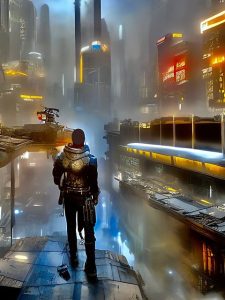Creating a thrilling story is like solving a puzzle – you must piece the threads together correctly to capture the reader’s attention and hold it from beginning to end.
Stream-of-consciousness writing is one technique to help capture the complexity of a thriller and bring your characters’ innermost thoughts to life. By blending inner monologue with elements of suspense and surprise, you can create intriguing thrillers that will keep readers enticed until the very last page.
What is stream-of-consciousness writing?
Stream-of-consciousness writing is a form of interior monologue in which the writer expresses the thoughts and feelings of one character as they unfold.
Unlike traditional narration, stream-of-consciousness writing does not follow a linear order. It jumps from one thought to another, often leading down an unexpected path. This technique can help create suspense by allowing readers to piece together clues in the characters’ inner world.
Introducing your characters and their inner worlds
Before embarking on a stream-of-consciousness writing journey, it is essential to take some time to develop your characters. Then, consider their backstories, beliefs, and motivations so that their inner worlds are more understandable.
Think about how these elements shape their thoughts and behavior, as this will give the story more depth.
Writing stream-of-consciousness scenes with tension and suspense
Once you have introduced your characters and their inner worlds, it’s time to start writing stream-of-consciousness scenes. To create gripping suspense, focus on moments that bring up intense emotions for your characters or reveal surprising secrets.
Take time to explore the events unfolding in your character’s minds, and use vivid language to draw readers into their worlds.
A stream-of-consciousness thought is an internal dialogue that runs through your head while engaging in activities such as daydreaming or taking a shower. It’s essentially how you talk to yourself, which can be quite different from how you speak to others.
Usually, a stream-of-consciousness thought involves a series of random ideas, questions, and musings about the world around us.
Here are some examples
1. What would happen if I quit my job tomorrow? Would I regret it in the future? How long could I last without a salary?
2. Have I been spending enough time with my family lately? Should I plan something special for this weekend?
3. Should I call the person who left me a voicemail yesterday? What should I even say if they answer the phone?
4. Is something new and exciting happening in my city this week worth checking out?
5. What will I do when summer finally arrives soon after so much winter weather has dragged on for months?!
As you write your stream-of-consciousness scenes, it is important to remember how they fit into the story as a whole.
Explore how it can help you create thrillers

Stream-of-consciousness writing can help you craft thrilling stories by allowing you to explore your characters’ inner worlds. You can use this technique to dive deep into their motivations and desires, adding a layer of complexity that is hard to capture in traditional narration.
By exploring the nuances of each character’s thoughts, feelings, and decisions, you can create gripping thrillers that will keep readers engaged until the very last page.
Types of stream of consciousness writing
Depending on the story you are trying to tell and your character’s inner world, there are a few types of stream-of-consciousness writing.
– Free Indirect Discourse is one style in which the thoughts and feelings of a character are expressed in the third person.
– Autonomous Monologue is another, in which the character’s thoughts are expressed directly in first-person narration.
Tips to keep in mind when writing stream-of-consciousness
• Use vivid descriptions to bring readers into your characters’ inner worlds.
• Take time to explore the nuances of each character’s motivations and desires.
• Focus on moments that evoke intense emotions or reveal unexpected secrets.
• Think about how stream-of-consciousness writing fits into the story as a whole.
Benefits of using stream-of-consciousness writing for your thriller
The benefits of using stream-of-consciousness writing for your thriller are vast. It provides insight into the characters’ inner worlds and can also build tension and suspense in a way that traditional narration cannot.
Additionally, this technique allows readers to experience the story more intimately and personally as if they were living the characters’ lives.
Stream-of-consciousness writing can also bring a heightened sense of realism to your story, allowing readers to fully explore the nuances of each character’s thoughts and feelings. With its ability to create gripping suspense and tension, stream-of-consciousness writing is an invaluable tool for crafting thrillers.
Tips on getting started with stream-of-consciousness writing
If you’re new to stream-of-consciousness writing, starting with some basic preparation is important.
– First, decide which character to focus on and create a backstory for them that will inform their inner monologue.
– Additionally, you should think about the key elements of your story – plot points, dialogue, etc., and how they will be reflected in the character’s inner world.
– Finally, when writing stream of consciousness, take your time to explore each character’s thoughts and feelings. This will create an immersive story that readers can’t help but be drawn into.
Examples of popular literary work utilizing stream-of-consciousness writing
Some of the most notable examples of stream-of-consciousness writing include:
– James Joyce’s work Ulysses is one of the classic examples in this genre. It follows Leopold Bloom through Dublin over a single day while providing his internal monologue as he continues his daily business. Throughout this impressive work, many key events are related through psychological analysis rather than action or plot development.
We can observe what is occurring externally and how all these occurrences affect Bloom’s inner dialogue – from wandering musings on memory and mortality to humorous ramblings that question everything from politics to religion.
– Virginia Woolf uses stream-of-consciousness to present multiple points of view in Mrs. Dalloway. The novel follows Clarissa Dalloway as she prepares for an evening party hosted by her friend Lady Bruton. However, her inner musings interact with and inform the novel’s external plot progression and its more metaphysical implications. For example, we witness Clarissa’s memories and fears concerning her past love affair with Peter Walsh; this information yields insight into Clarissa’s motivations for marrying Richard rather than accepting Peter’s proposal.
– William Faulkner’s As I Lay Dying similarly follows multiple perspectives but focuses primarily on family dynamics and relationships between parents and children over three days across rural Mississippi as they mourn for Addie Bundren, who died at home in bed after an unspecified illness that had been afflicting her for years before her death.
– Virginia Woolf’s To The Lighthouse, set on a Scottish island before and after World War I, explores the emotions of its characters through their inner monologues rather than dialogue or action. One example is Mrs. Ramsay’s reflections: “She had seen death kill; make cruel rents in living things… She thought that all pleasure must have the pain to garnish it, but she wanted to rest her spirit there where pleasure reigned unchecked forever… We die together, she thought.”
– Marcel Proust’s 1913 text Remembrance Of Things Past shines when it comes to exemplifying stream-of-consciousness writing at its finest moments by detailing heavy subjects such as identity confusion and nostalgia for childhood memories evoked through its narrator’s meanderings across Parisian landscapes.
He did all this via introspective musings about his past life experiences and those around him – enriching our understanding if not mirroring our plights felt throughout our lives today, even now over 100 years later since its original publication date!
All told, these extraordinary examples demonstrate how powerful literature using a stream-of-consciousness narration style remains even today – making them timeless pieces that stay relevant decade after decade given their ability to capture what each ordinary moment contains: joy amid sadness or hope alongside despair – something we can all relate too no matter what era we inhabit now or exist within future generations ahead to come!
Examples of popular movie scripts utilizing stream-of-consciousness writing

Stream-of-consciousness writing is not limited to literature – it can also be used in movie scripts.
Here are a few examples
– One iconic example of stream-of-consciousness writing being used effectively in cinema is Stanley Kubrick’s The Shining (1980). This horror movie follows Jack Torrance, played by Jack Nicholson, who begins to experience increasingly violent hallucinations at a remote mountain resort. Through stream-of-consciousness narration, we get insight into his tormented mind, allowing us to share his psychological terror before eventually succumbing to madness.
– Another great example comes from Ridley Scott’s Blade Runner (1982), based on Philip K Dick’s cult novel Do Androids Dream of Electric Sheep? Its protagonist Deckard struggles with existential questions about his true identity while searching for escaped replicants; these themes are explored through constant consciousness streams throughout the movie.
– Streams of conscience were also heavily utilized in current television shows such as HBO’s Westworld and Netflix’s Stranger Things – both drawing inspiration from some classic horror novels like Lovecraftian works featuring entities traveling beyond dimensions via interdimensional portals along with supernatural creatures awaiting their arrival.
– More recently, we have seen examples of this device in Christopher Nolan’s Inception (2010), Darren Aronofsky’s Black Swan (2010), and Spike Jonze’s Her (2013).
All these scripts masterfully combine elements of dream logic with slow-burning psychological horror – vampiric on viewers’ subconscious minds until they reach their logical conclusions – all thanks to the effective utilization of stream-of-consciousness writing, a narrative technique implemented by talented screenwriters!
Conclusion
From exploring stream-of-consciousness writing and how it can help you create thrillers to picking up tips on how to get started with this genre, this blog post has hopefully given you a great insight into the possibilities of stream-of-consciousness writing.
We have also looked at famous literary works and movies that used the technique to tell their stories successfully – so now you know just how versatile it can be! While it may take some time and effort to master this writing style, the rewards could be huge as your thriller takes shape and gets ready to rivet readers worldwide.
So why not give it a go? Your work might be the next great story!
Thank you for taking the time to read. May you find success and joy in all that you create.
If you’re working on your first novel and are looking for more help with your writing, please check out my other articles at https://ullahakanson.com/blog/
Best of luck with your writing!
Ulla
www.ullahakanson.com

